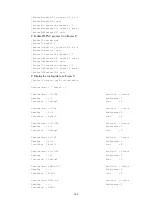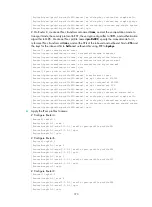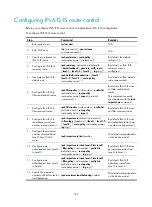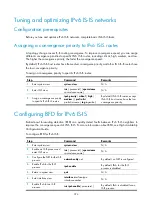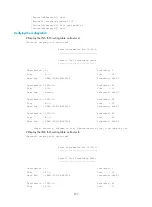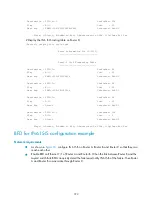
368
Figure 91
Network diagram
Configuration procedure
1.
Configure IPv6 addresses for interfaces. (Details not shown.)
2.
Configure OSPFv3 basic functions:
# On Router A, enable OSPFv3 and configure the router ID as 1.1.1.1.
<RouterA> system-view
[RouterA] ospfv3 1
[RouterA-ospfv3-1] router-id 1.1.1.1
[RouterA-ospfv3-1] quit
[RouterA] interface ethernet 1/2
[RouterA-Ethernet1/2] ospfv3 1 area 1
[RouterA-Ethernet1/2] quit
# On Router B, enable OSPFv3 and configure the router ID as 2.2.2.2.
<RouterB> system-view
[RouterB] ospfv3 1
[RouterB-ospfv3-1] router-id 2.2.2.2
[RouterB-ospfv3-1] quit
[RouterB] interface ethernet 1/1
[RouterB-Ethernet1/1] ospfv3 1 area 0
[RouterB-Ethernet1/1] quit
[RouterB] interface ethernet 1/2
[RouterB-Ethernet1/2] ospfv3 1 area 1
[RouterB-Ethernet1/2] quit
# On Router C, enable OSPFv3 and configure the router ID as 3.3.3.3.
<RouterC> system-view
[RouterC] ospfv3 1
[RouterC-ospfv3-1] router-id 3.3.3.3
[RouterC-ospfv3-1] quit
[RouterC] interface ethernet 1/1
[RouterC-Ethernet1/1] ospfv3 1 area 0
[RouterC-Ethernet1/1] quit
3.
Configure OSPFv3 IPsec profiles:
# On Router A, create an IPsec transform set named
trans
, and set the encapsulation mode to
transport mode, the security protocol to ESP, the encryption algorithm to 3DES, and authentication
algorithm to MD5. Create an IPsec profile named
profile001
, specify the manual mode for it,









